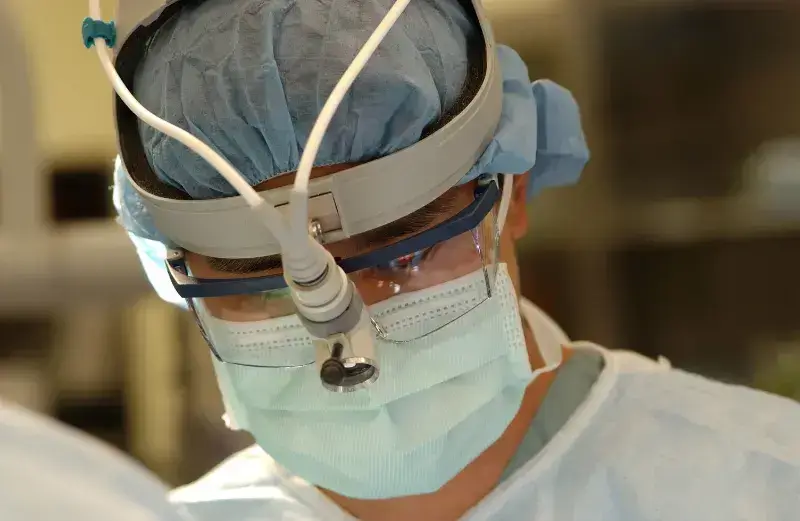Diagnosis & Treatment - Salivary Gland Tumors
Salivary gland cancer treatment in Ahmedabad
Salivary Gland Cancer Diagnosis
Making an accurate diagnosis is a key first step in developing the best treatment plan for salivary gland cancer.

As part of this process, we will be able to conclude:
- Which type of salivary gland cancer you have
- whether the cancer is growing slowly (low-grade salivary gland cancer) or quickly (high-grade salivary gland cancer)
First, we will take a complete medical history. They will want to know about any risk factors you may have, such as prior cancer treatments or exposure to radiation in the workplace.
Salivary Gland Biopsy/ Fine Needle Aspiration Cytology(FNAC)
During a salivary gland biopsy/FNAC, we take a small amount of abnormal tissue from the gland where cancer is suspected. The tissue sample is then sent to a pathologist who examines it under a microscope.
Diagnostic Imaging for Salivary Gland Cancer
Special x-rays may be done. These include CT scans, MRIs, or Panorex. These imaging tests provide more details about the tissue extension and involvement. If cancer is found, the scans can show how deep the cancer is and if it has spread.
Hormone Receptor Status
Tumor markers are substances that are produced in excess by cancer or by other cells of the body in response to cancer or certain benign (noncancerous) conditions. A pathologist can measure for tumor markers using a sample of tumor tissue or bodily fluid, such as blood or urine.
Salivary Gland Cancer Treatment
Surgery is the mainstay of treatment for salivary gland tumors by an expert head and neck cancer surgeon. Surgery is done with the intent to remove the whole tumor in totality. Radiation therapy and Chemotherapy are more often for advanced salivary gland cancers.
Salivary Gland Surgery
Parotidectomy
Parotidectomy is the name of the surgery used to remove a benign or cancerous tumor in the parotid glands. This operation requires particular care and expertise because the facial nerve and other structures are nearby.
The complete removal of your tumor, combined with the preservation of the facial nerve, is the priority for us. We have extensive experience in using precise surgical techniques that help preserve the facial nerve. In addition, we use the most-advanced facial nerve monitoring technology. It allows them to find the facial nerve during the surgery.
Submandibular Gland Excision
To treat a benign or cancerous tumor in the submandibular glands, your surgeon removes (excises) the affected gland. Submandibular gland excision requires precision on the part of your surgical team. There are important nerves nearby, including:
- The marginal mandibular nerve, which helps you smile
- The lingual nerve, which allows sensation in the tongue
- The hypoglossal nerve, which allows movement in the part of your tongue that helps with speech and swallowing
Sublingual Gland Excision
Surgery for tumors in a sublingual gland involves removal (excision) of the entire gland. Sublingual gland excision requires precision on the part of your surgical team because the lingual nerve is nearby. The lingual nerve controls feeling and taste on the side of the tongue. The surgical team will preserve the lingual nerve whenever possible
Minor Salivary Gland Cancer Surgery
Minor salivary gland cancer can occur in your lips, tongue, roof of the mouth (palate), inner cheek, throat, voice box (larynx), nose, and sinuses. Your surgeon usually removes some surrounding tissue along with the cancer. The exact details of surgery depend on the size and location of the cancer.
Lymph Node Removal
Salivary gland cancers often spread to the lymph nodes in the neck first before they spread anywhere else. Removing the lymph nodes in the neck (and other nearby tissue) is done at the same time as the surgery to remove the cancer. The goal is to remove lymph nodes shown to contain or that are likely to contain cancer.
Treatment for Facial Paralysis (Facial Reanimation)
Loss of facial nerve function related to the treatment of a parotid gland tumor can result in partial or total paralysis on one side of the face. This can greatly impair a person’s ability to make basic movements of the face, such as raising the eyebrows, closing the eyes, or smiling. It can be accompanied by vision loss and, possibly, difficulty eating or speaking.
We have developed highly specialized techniques for treating facial paralysis so people can regain these abilities after treatment. By transferring or transplanting muscles and nerves from other parts of the body or rewiring nerves, we can restore movement within months. This procedure is known as facial reanimation. It may be done when the tumor is being removed or even years after treatment in some cases.
Know More
Know More
Know More
Know More
Know More
Specialization
Oral (Mouth) Cancers Tongue Cancers Throat Cancers (Laryngeal and Pharyngeal Cancers) Thyroid Tumors Parathyroid Tumors Nasal and Paranasal Sinus Cancers Anterior and Lateral Skull Base Cancers Salivary Gland TumorsContact Us






